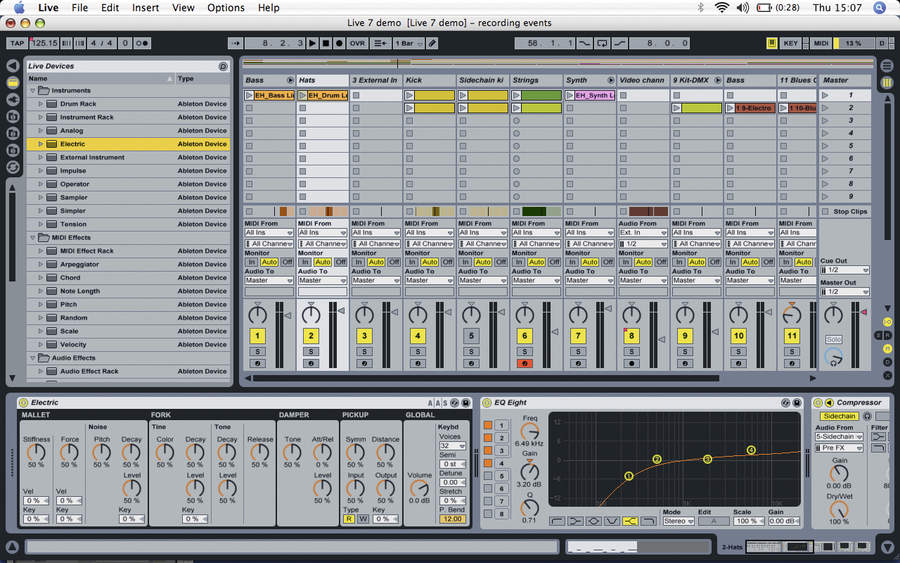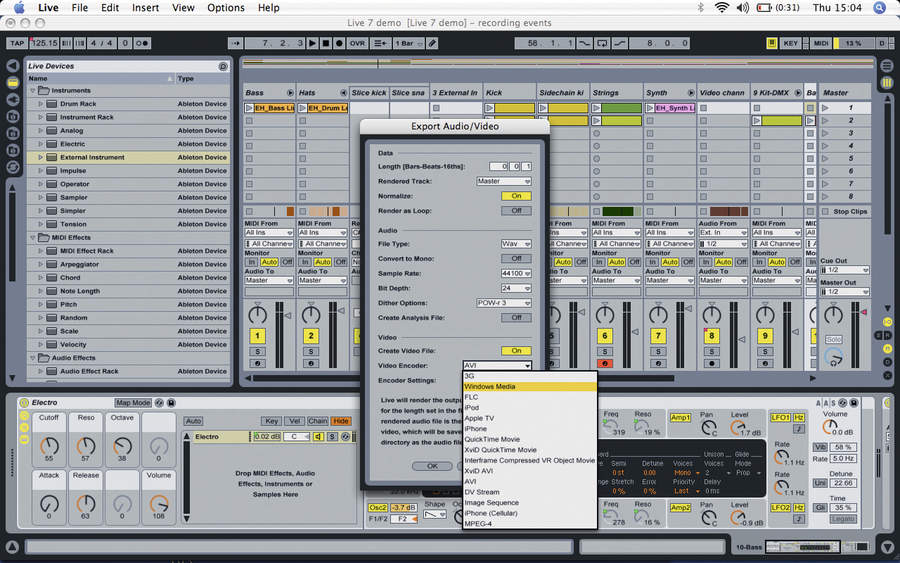MusicRadar Verdict
Live 7 is held back from full marks because it misses a few important tricks. However, despite any shortcomings, it remains a uniquely creative DAW.
Pros
- +
Sidechaining is great. Drum Racks are fantastic. Improved sound quality. Better live play and DJing facilities. REX import and slicing.
Cons
- -
No MIDI groove mapping. Nothing that innovative. A few common requests ignored... again!
MusicRadar's got your back



Visually, almost nothing has changed in Live 7. Ableton clearly thinks that it has the Live interface sussed now, as it's damn near identical to the one in version 6.
But what about under the bonnet? The first major improvement you come across in Live 7 is the long-overdue inclusion of true sidechaining, which is vital to modern production.
The next really big addition is Drum Racks. Initially, we thought these were cool, but nothing really groundbreaking. However, the more we use them the more we love them.
The basic idea is of a drum machine with a matrix-style interface, but it's so much more than that.
Each drum cell gets its own channel in the Drum Rack mixer (which can be hidden or displayed in the Session view mixer at the push of a button) and can host any instrument and effects chain you like, so the Drum Rack becomes an entire custom-made bus group.
The REX files
Closely linked to Drum Racks is another new and stonkingly good feature - REX support. Sure, this was probably overdue, but it's here now, and works really well. You simply drop in a REX file like any other audio file, and it picks up the chop points and displays them.
Want all the hottest music and gear news, reviews, deals, features and more, direct to your inbox? Sign up here.
We did occasionally hear the odd tiny click at the slice points, but fortunately that doesn't matter too much, thanks to an even cooler related addition: slicing.
This does exactly what it says on the tin. With REX files, it slices the audio up (according to REX slice-points or Warp Markers and beat divisions), places it in a series of Simplers in a Drum Rack-style interface and creates a MIDI file.
You then have the same control over each slice as if it were a self-contained sample. And of course, this is all non-destructive.
Now, one feature that was handy in Live 6 but extremely rudimentary was video support. Sure, you could sequence the video and even warp it, should you desire, but there was no way to export the fruits of your labours.
Well, exporting is now catered for, and, basic though it may be, you can still warp the video first. Even so, we'd like to see, at the very least, some kind of video cross-fading tool. With the proliferation of VJs out there these days - not to mention the cool effects you can get from warping video to fit your audio - we don't think that it would be an innovation too far.
Whereas Live mixdowns previously lacked some of the professional sheen and character of competing applications, the software now uses 64-bit summing wherever signals are mixed, and there is indeed a marked difference in audio quality.
Things we wanted
Ableton has clearly listened to the requests of its users, as a whole raft of features we've been asking for have been added.
First of these is the ability to change time signatures both mid-project and on the fly. So, for example, you can link different scenes in the Session view, enabling bands to have whole sets loaded into one Live set, rather than them having to load up a new project for each song. From a live performance perspective, this is a considerable leap.
And speaking of live performance, DJs will finally be able to mix Live with 'real' decks with confidence thanks to the new tempo nudge buttons. Not only that, but MIDI control over tempo has also been enhanced, enabling the use of two controllers: one for coarse control, the other for setting the decimal portion of the tempo.
The glorious new automation track lanes will be a breath of fresh air for anybody who's ever mixed a compilation album in Live, as they enable you to keep track of multiple critical parameters simultaneously; however, once you add an automation lane, you can't alter what the previous one is displaying (though you can alter the automation), which proves a little restrictive.
Some of the remaining feature highlights include easy hardware integration, enabling external instruments and effects to appear in the mixer rack as if they were plug-ins, improved MIDI timing for incoming data (and it's noticeably better, too!) and even a tasty spectrum analyser with loads of useful options.
In summary
Despite a few persistent niggles and omissions, each new version of Live has brought genuine and material improvements to your workflow, to the point where you simply couldn't go back to using the previous one.
But we didn't get quite that same sense of progress when we first launched version 7. There's nothing groundbreaking - just stuff that brings the software into line with the competition.
And there are still gaps. For example, with so much modern music production being based around groove quantisation, and software such as Reason pushing the boundaries of both quantisation and groove-mapping, Live is starting to look like it's being left behind in this respect.
In version 7, we would have liked not just the ability to learn MIDI quantisation maps, but to apply them to warped audio too. And how about the ability to play tracks with tempo changes in the Session view? Oh, and there's still no scissors tool.
So, should existing users upgrade? Well, ultimately, yes. It is improved, it is worth having, and once you get used to it, it is hard to go back to 6. But it still feels more like Live 6.5.
If you don't own Live at all, though, there are at least 15 good new reasons why you're missing out and need to buy it right away.
MusicRadar is the number 1 website for music makers of all kinds, be they guitarists, drummers, keyboard players, djs or producers...
- GEAR: We help musicians find the best gear with top-ranking gear round-ups and high- quality, authoritative reviews by a wide team of highly experienced experts.
- TIPS: We also provide tuition, from bite-sized tips to advanced work-outs and guidance from recognised musicians and stars.
- STARS: We talk to musicians and stars about their creative processes, and the nuts and bolts of their gear and technique. We give fans an insight into the actual craft of music making that no other music website can.
